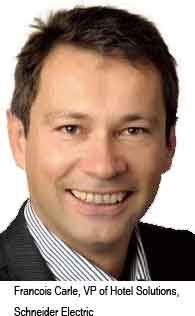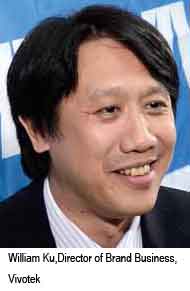Security is only one piece of the hotel management puzzle. By plugging security systems into building automation, greater management efficiency and cost savings can be better realized.
Security is only one piece of the hotel management puzzle. By plugging security systems into building automation, greater management efficiency and cost savings can be better realized.
Security is just an aspect — an important one nonetheless — of overall hotel management and operation. With hotels getting larger and facility management getting more complex, hoteliers are hard-pressed to move to converged and greener solutions in order to minimize TCO.
“Security installation is one aspect of overall protection; another aspect is how it is managed,” said Michael Hartmann, Head of Market Development Board of Siemens One Hospitality, Siemens Building Technologies. “The increasing complexity of networks and technologies involved in securing a hotel means that it is becoming impossible for hotel operators to have all the experts on-site. Technology convergence is also progressively bringing security and IT departments together, but security professionals are not necessarily IT experts. A big challenge for hotel operators is, therefore, to ensure only professionally trained employees are managing the systems. This is a challenge that can be addressed through the outsourcing of certain tasks, and indeed this is a growing trend in security and safety functions, from remote monitoring to complete alarm management.” 
“An integrated solution enables hotel management to be mindful of environmental concerns by providing actionable information with which energy can be maximized and waste reduced,” said Francois Carle, VP of Hotels Solutions, Schneider Electric. “This kind of information can be easily accessed and shared. Different stakeholders can be notified of possibilities for economies of scale or made aware of issues that cause waste — then they can act accordingly. IP facilitates this integration design.”
Centralized or Decentralized
At sizable hotel resorts today, a piecemeal approach where individual systems and areas are secured and managed separately is no longer viable. “For integrated resorts and larger hotels, both centralized and decentralized solutions are needed,” explained Patrick Lim, Director of Sales and Marketing, Ademco Far East. “For instance, there are solutions that allow all subsystems and devices to be centrally monitored or recorded, but they also allow each area to have its own ‘mini' monitoring system. This way, security personnel at individual sites can react with more information, while centrally the security management team retains control of information and maintains the ability to monitor anywhere.”
 Opting for centralized or decentralized management depends on the operation requirements of the organization, added Nafis Jasmani, Regional Manager for ASEAN, Axis Communications. “Factors include available infrastructure, system scalability and other specific requirements. As centralized and decentralized systems have different cost structures, it is important to also understand that system designs serve specific purposes rather than compromising critical operations.”
Opting for centralized or decentralized management depends on the operation requirements of the organization, added Nafis Jasmani, Regional Manager for ASEAN, Axis Communications. “Factors include available infrastructure, system scalability and other specific requirements. As centralized and decentralized systems have different cost structures, it is important to also understand that system designs serve specific purposes rather than compromising critical operations.”
Going Greener
Unlike energy or HVAC controls, hotel security must be up and running 24/7. Temporary power outages pausing live monitoring or preconfigured down times for different zones are luxuries that a hotel system cannot afford. While some initial investment may be unavoidable, a well-designed, implemented and maintained system pays off in the long run, with measurable energy/ cost savings and carbon footprint reductions.
One way is to automate systems in such a way that energy consumption is regulated based on demand or predefined settings, Hartmann said. “In conference rooms, we start to see prescheduled climate settings linked to the room user ID through a touch screen that activates predefined patterns based on the number of participants,in guest rooms, we see a trend toward combining RFID-based door locks with motion sensors inside the room to confirm occupancy and trigger relevant systems in the room. At the same time, the identity of the room occupant — guest or housekeeping staff — can be determined with room automation functionality matched to the needs, such as opening blinds or triggering full lighting and HVAC for guests, and reduced lighting and no automatic blind opening for housekeeping.”
Another key trend in hotel technologies is the rapid development and deployment of sensors. “Passive sensors with unidirectional data sending functionality are still well-received, but active sensors where guests can interact with systems, meaning data exchange takes place between devices, are growing in use and fields of application, supported by technologies such as RFID,” Hartmann said.
For instance, access control to guest rooms or conference centers can trigger lighting and HVAC inside, ensuring that no energy is wasted when the rooms are empty. Integrating parking management with the security system is not uncommon, which makes available real-time entry authorization, video recording and ALPR, Hartmann added. “Combined with parking guidance, such a system also optimizes guest convenience through seamless entry and improved speed of finding a free parking space. This can have a positive impact on the hotel's carbon footprint, as gas consumption and carbon emissions are reduced. In addition, motion sensors can trigger lighting on demand, and carbon monoxide detectors can activate parking ventilation when a critical concentration is reached.”
 Even energy consumption from surveillance cameras can be minimized . “ Streaming video footage to the central control room consumes the most power, and one way for hotels to regulate this consumption is by setting streaming time to avoid constant power usage,” said William Ku, Director of Brand Business at Vivotek. “Another way to be power-efficient is to fully use the local storage capacity on individual cameras. Most users utilize local storage as backup since memory is limited and excessive rewriting causes cameras to break down much faster. We anticipate that in one year when terabyte memory becomes introduced into cameras, local storage will be more desirable and convenient for users.”
Even energy consumption from surveillance cameras can be minimized . “ Streaming video footage to the central control room consumes the most power, and one way for hotels to regulate this consumption is by setting streaming time to avoid constant power usage,” said William Ku, Director of Brand Business at Vivotek. “Another way to be power-efficient is to fully use the local storage capacity on individual cameras. Most users utilize local storage as backup since memory is limited and excessive rewriting causes cameras to break down much faster. We anticipate that in one year when terabyte memory becomes introduced into cameras, local storage will be more desirable and convenient for users.”
No matter how a hotel decides to incorporate security elements into its building management system, the ultimate goal is to make sure that the protection the security system offers is realistic and maximized to conform to the hotel's daily operations and requirements. “Our job is to guide the customer as we design a realistic solution that takes into account the size of the implementation, the configuration of other solution component, the way things are integrated and what information is available to whom. Optimizing the solution is a must for every project,” Carle said.